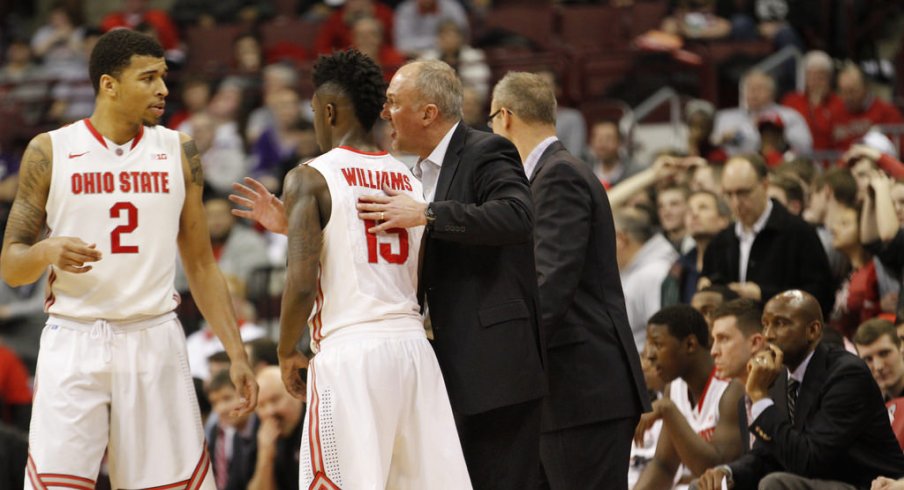At one point in Thad Matta's tenure, his teams were at their most lethal on inbounds plays.
Although I have reasons to believe he did not have a large sample size to support this stance, Dan Dakich once called Matta the best coach in the country at designing inbounds plays from the baseline. His ability to draw up these plays, also known as BLOBs, were no doubt aided by Sam Thompson. The high-flying former Buckeye repeatedly scored off alley-oops on BLOBs throughout his four years at Ohio State.
Thompson did it in a variety of ways. He could start from the top of the key, beat his defender on a backdoor cut and leap over any help defense standing in his way. The most common way involved him screening as a decoy and then receiving a down screen of his own to open up space for him to throw down off a lob.
Kam Williams has similar athletic talent but he wasn't a recipient of this version of a Sam Thompson alley-oop play. I promise this is the only time I will subject you to footage from the Michigan game; Marc Loving comes around a Trevor Thompson screen on the right block – an obvious decoy, any Loving alley oop attempt is risky – then Keita Bates-Diop sets one for Trevor Thompson:
It wasn't well executed and Michigan eventually turned it into a bucket at the other end. Good to know it's still in the Buckeye repertoire, regardless.
Not all Ohio State BLOB actions result in an immediate shot attempt. Some great, extended motion came off this inbound. First, it shows the importance of off-ball screening to a competent offensive game plan and to getting a good shot off.
Watch how Loving's defender struggles to keep up with him as he sets two screens and loops around Mickey Mitchell. Nebraska's help defense was solid and Mitchell wasn't in the best spot to receive a pass from Loving but, luckily, Loving was able to finish through contact:
The Buckeyes ran several out-of-bounds sets in a close contest against the Huskers. It was far from the most important aspect of that game, but a few more buckets off BLOB actions could've prevented overtime.
From the beginning, I like what Ohio State did here schematically. Bates-Diop's length is helpful and coaches always preach the importance of watching the inbounder, not just the ball. Kam Williams essentially pushes his defender into Bates-Diop's and isolated him against the shorter Nick Fuller.
Ideally, Williams sprints to the corner immediately after Bates-Diop catches in the post, the defense respects Mitchell's three-point shooting ability on the wing and Lyle is closer to the top of the key. The lack of space means Bates-Diop has a tough time getting a shot off when the defense collapsed.
Still, he had an open Loving in the right corner. The flaw was in the execution, not the design:
One of the most important sequences during this game occurred on a sideline out of bounds play. I figured Ohio State would want to attack early given the situation. If the Buckeyes missed or turned it over, time becomes a major concern and Matta doesn't have any timeouts left.
Here, Bates-Diop is stationed on the left block as the ball is inbounded. Once Loving gets into position at the elbow, Bates-Diop runs through a set of staggered screens which appear to free him for a curl to the basket.
That might've been a decoy, as Lyle never looks there and Loving runs off a Mitchell screen on the wing. Had Mitchell properly set the screen and not run towards the ball, Loving has a chance at an open three to give OSU the lead:
Eventually, Lyle attacked the basket himself, drew a foul and tied the game with two free-throw makes. Ohio State got a stop at the other end, went to OT and won the game.
It all worked out in the end. Some heightened execution on these well-designed sets could prevent overtime in the future, however.


